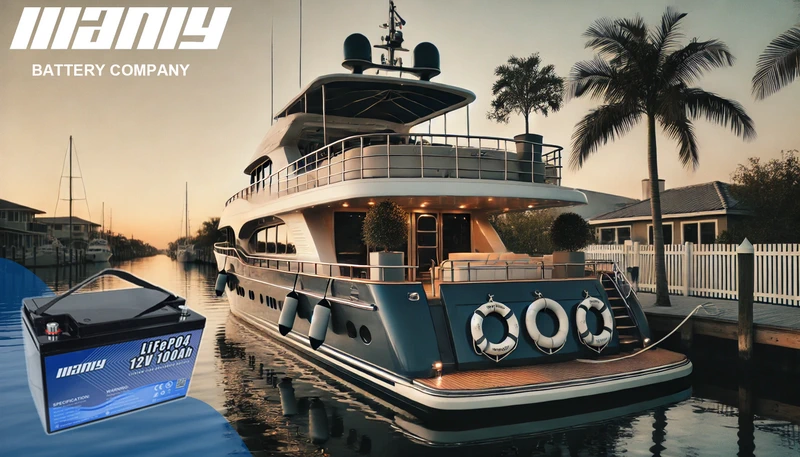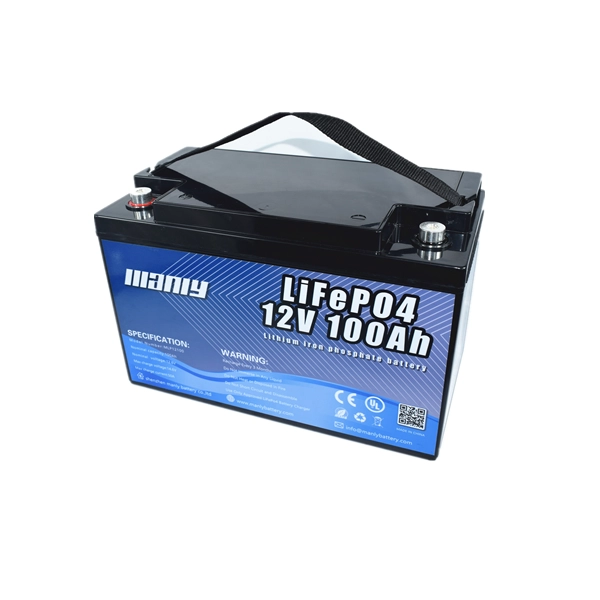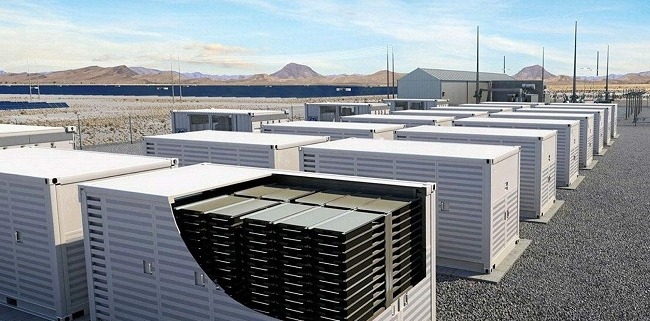What Type of Battery is a Marine Battery? A Detailed Breakdown
Table of Contents
- What Type of Battery is a Marine Battery? A Detailed Breakdown
- What is a Marine Battery?
- Different Types of Marine Batteries and Their Features
- The Best Choice: LiFePO4 Batteries for Marine Use
- Why LiFePO4 Batteries Are the Best Marine Batteries?
- Conclusion
- FAQ
- Hot Search
- Definition and Types of Agricultural Robots
- 1. Definition of agricultural robot:
- 2.How Are Robots Used in Agriculture
- 3. Types of Agricultural Robots:
- 4. Lithium Batteries for agricultural robots
- 5. Conclusion
- Ultimate Electric Jet Surfboard Guide for 2024
- Glide on Water with Amazing Jet Surfboard
- History Of Electric Jet Surfboard
- Types of Electric Jet Surfboard
- Where and How To Ride Your Electric Jet Surfboard
- Riding Styles for Electric Jet Surfboards: Sporty or Relaxed?
- Choosing Your Electric Jet Surfboard: Handle or No Handle?
- Staying Safe on Your Electric Jet Surfboard
- The Thrill of Electric Jet Surfboard: Power and Speed
- Power Up Your Surf with LiFePO4 Lithium Batteries
- Cost of Electric Jet Surfboard
- Sungrow signed a contract with Israel’s largest energy storage project
Maintaining a consistent and dependable boating experience depends on choosing the right marine battery. Whether you use a trolling motor, start your engine, or run electronics, the appropriate battery type will make all the difference. The several choices for batteries make many sailors find it difficult to choose the right one.
This article will break apart lead-acid, AGM, gel, and LiFePO4 batteries as well as other types of marine batteries. You will learn every type in great depth, including its benefits, drawbacks, and optimal uses. By the conclusion, you will understand the reason LiFePO4 batteries are the best fit for marine applications.
What is a Marine Battery?
Designed especially to withstand adverse sea conditions, a marine battery is Unlike automobile batteries, which only provide short bursts of electricity to start an engine, marine batteries must deliver constant power for lengthy durations while tolerating vibrations, dampness, and temperature variations.
- Usually driven by its intended use, marine batteries are categorized:
- The starting battery runs the boat motor. It gives a brief, sharp boost but lacks long-term vitality.
- Deep-cycle batteries run constantly for lights, fish finders, and trolling motors among other equipment.
- A dual-purpose battery sometimes performs worse than dedicated beginning and deep cycle batteries, even if it aims to combine two uses.
These classification indicate the use of a marine battery, although the most important factor influencing battery performance is battery chemistry. Chemistry of a battery determines its general performance, longevity, efficiency, and maintenance requirements.
Different Types of Marine Batteries and Their Features
The several kinds of marine batteries are listed below, together with their characteristics:
Lead-Acid Marine Batteries
Lead-acid batteries have been used in marine conditions as they have been rather competitively priced and widely available for decades. These batteries chemically react with lead plates and sulphuric acid to generate power.
Flooded Lead-Acid (FLA) Batteries
Flooded lead-acid batteries are the most classic form. They demand consistent maintenance, including topped off distilled water. They are heavy, require ventilation, have a shorter lifetime than other battery types even if they are economically priced.
Sealed Lead-Acid Batteries
Lead-acid batteries sealed eliminate maintenance needs and are spill-proof. Two most widely used variants that improve performance over typical flooded lead-acid batteries are AGM (absorbed glass mat) batteries and gel batteries.
Advantages of Lead-Acid Marine Batteries
Lead-acid batteries are reasonably cheap and rather numerous. Their great starting current makes them worth using for engine cranking.
Disadvantages of Lead-Acid Marine Batteries
Lead-acid batteries need regular maintenance, weigh a lot, and charge slowly. Usually running for two to four years, their lifetime is short; they break down upon discharge below 50% capacity.
AGM (Absorbed Glass Mat) Marine Batteries
AGM batteries are spill-proof and maintenance-free by absorbing the electrolyte using fiberglass mats, therefore improving traditional lead-acid designs.
How do AGM Batteries Work?
By immobilising the electrolyte inside the glass mat, AGM batteries reduce the possibility of leaking and hence maximise power efficiency. Since this structure lets for better resistance to vibrations and faster charging periods, AGM batteries are a more durable replacement for flooded lead-acid batteries.
Advantages of AGM Marine Batteries
Zero maintenance and faster charging than other lead-acid models describe AGM batteries. Their lifetime is between three and six years, and they have more resistance to deep discharges.
Disadvantages of AGM Marine Batteries
AGM batteries remain heavier than lithium alternatives even with their superior performance. On a tight budget, they also appeal less to boaters since they cost more than flooded lead-acid batteries.
Gel Marine Batteries
Gel batteries use liquid electrolytes from a silica-based gel. Less leaks and greater deep discharge performance are made possible by this chemical composition.
How do Gel Batteries Work?
The gel-based electrolyte lowers chemical reactions, therefore reducing the possibility of overcharging or deep discharge. Applications needing constant, long-term power will find ideal use for these batteries.
Advantages of Gel Marine Batteries
Gel batteries resist high temperatures, maintain a longer lifetime than flooded lead-acid batteries, and require no maintenance.
Disadvantages of Gel Marine Batteries
The slow charging rate of gel batteries is its biggest drawback. Furthermore expensive than AGM and flooded lead-acid batteries are they are. Less forgiving than other battery kinds, overcharging can damage a battery permanently.
The Best Choice: LiFePO4 Batteries for Marine Use
The most intelligent and powerful marine batteries are LiFePO4 (Lithium Iron Phosphate). Unlike lead-acid batteries, which rely on chemical interactions between lead and acid, they offer constant and dependable power by means of lithium-ion technology.
Why LiFePO4 Batteries are Superior?
Among their most important benefits are LiFePO4 batteries’ extended lifespan. Lead-acid batteries run two to six years; LiFePO4 batteries can run ten years or more. Since they weigh up to 70% less than lead-acid batteries and are more easily handled, they also greatly improve boat performance.
Charging time offers still another major advantage. Five times faster charging of LiFePO4 batteries than with lead-acid batteries Unlike lead-acid batteries, which have to be kept above 50% charge, they also enable total discharges free from battery damage.
Are There Any Drawbacks to LiFePO4 Batteries?
The sole negative of LiFePO4 batteries is their starting cost. For seasoned sailors, however, they are the most affordable choice because of their long lifetime, fast charge times, and low maintenance needs.
Why LiFePO4 Batteries Are the Best Marine Batteries?
LiFePO4 batteries have long-term benefits above all other battery models, even if their initial expense makes many sailors unwilling to switch. Boats carrying LiFePO4 batteries had 30% longer running lifetime on electronic systems and trolling motors, according a study by marine engineers.
Savings in weight also improve performance. LiFePO4 technology lets a boat greatly reduce the weight of its battery, therefore enhancing fuel economy and general maneuverability. Boaters looking for dependability, fast charging, and long-lasting performance would best invest in LiFePO4 batteries.
Conclusion
The perfect sailing voyage depends on selecting the right marine battery. Though lead-acid, AGM, and gel batteries are still somewhat popular, none give the efficiency, lifetime, and long-term savings LiFePO4 batteries offer.
LiFePO4 batteries from MANLY Battery provide the finest answer if you want a dependable and high-performance marine battery. Their innovative lithium technology guarantees exceptional energy economy, therefore assuring that your boat keeps running without the trouble of regular replacements.
For premium-quality marine batteries, visit MANLY Battery today and experience the next generation of marine power solutions.
FAQ
1. Is a deep cycle battery the same as a marine battery?
Let’s clarify: a deep cycle battery and a marine battery aren’t the same, although they have similarities. Here’s why:
A deep cycle battery provides a steady power flow over an extended period. It’s designed for applications that need consistent energy, like golf carts, RVs, or renewable energy systems. These batteries are built to handle repeated discharges and recharges without losing performance.
On the other hand, a marine battery is specifically made for boats. However, marine batteries come in two types: starting and deep cycle. A starting battery delivers a quick surge of power to start the engine, while a deep cycle marine battery powers your boat’s electronics and other devices.
So, while some marine batteries are deep cycle, not all deep cycle batteries work as marine batteries. If you’re choosing a battery for your boat, ensure it’s designed for marine use to get the most reliable power.
2. What are the three types of marine batteries?
Marine batteries come in three main types, each serving a different purpose. Understanding their roles helps you pick the right one for your boat:
- Starting Batteries: Starting batteries provide a quick burst of power to start your engine. They’re all about delivering a high-energy jolt for a short time. These batteries are not designed to power other devices, so they focus only on getting your engine running.
- Deep Cycle Batteries: Need power for your boat’s electronics, trolling motor, or other accessories? Deep cycle batteries are your answer. They deliver steady, long-lasting energy and can discharge and recharge multiple times without losing capacity. Perfect for extended trips or when you’re off the grid!
- Dual Purpose Batteries: As the name suggests, dual purpose batteries combine the functions of both starting and deep cycle batteries. They give you enough power to start your engine and supply energy to your accessories. They offer versatility but may not provide as much power as a dedicated starting or deep cycle battery.
Hot Search
Marine Lithium Battery Battery Manufacturer
Hello
1. Definition of agricultural robot:
Table of Contents
Agricultural robot is a robot that integrates various cutting-edge science and technology such as sensing technology, monitoring technology, artificial intelligence technology, communication technology, image recognition technology, precision and system integration technology. It is also an interdisciplinary and comprehensive integration of detection and sensing technology, information processing technology, automation control technology, servo drive technology, precision machinery technology and computer technology.
2.How Are Robots Used in Agriculture
Robots are widely used in agriculture to revolutionize farming practices and address the challenges faced by the industry. These robots offer numerous benefits and advancements that enhance farming efficiency and productivity. They are equipped with cutting-edge technologies, including artificial intelligence and machine learning, to perform complex tasks efficiently.
Agricultural robots provide real-time data gathering and analysis capabilities through the use of drones, enabling informed decision-making in crucial farming processes such as planting, irrigation, and pest control. This data-driven approach leads to improved crop yields, reduced costs, and optimized resource allocation. These robots also offer enhanced efficiency compared to traditional farming methods, resulting in significant time and cost savings for farmers.
The implementation of robots in agriculture faces challenges such as high initial investment costs and the lack of rural infrastructure for large-scale adoption. However, successful deployments have been observed worldwide, with Japan and Europe leading the way in utilizing robots for tasks such as harvesting, soil analysis, weeding, pruning, and planting. These robots have demonstrated increased efficiency and cost reduction in farming operations.
The development and integration of artificial intelligence into agriculture have further expanded the capabilities of agricultural robots. AI-driven decision support systems, such as yield prediction systems, enable farmers to make informed choices based on large datasets and sophisticated computer programs. This integration allows for more precise and optimized farming practices, contributing to increased agricultural productivity and sustainability.
Responsible innovation and user-centered design are crucial considerations in the development and adoption of autonomous robots in agriculture. As the field of agricultural robotics continues to evolve, ongoing research and inclusive discussions are needed to address ethical, social, and policy issues related to the responsible use of these technologies.
In conclusion, robots have transformed agriculture by offering advanced capabilities in data gathering, analysis, and decision-making processes. With their integration of artificial intelligence and machine learning, agricultural robots enable farmers to achieve higher efficiency, productivity, and sustainability in farming practices. The ongoing development and adoption of these technologies contribute to the growth and evolution of the agricultural industry.
3. Types of Agricultural Robots:
3.1 Picking Robot

The introduction of picking robots in agricultural has the potential to revolutionize farming practices and address key challenges faced by the industry. As the world’s population continues to grow, there is an increasing demand for food production. However, labor shortages and the need for higher productivity and efficiency pose significant obstacles.
Agricultural robots, including picking robots, offer promising solutions to these challenges. These robots can automate labor-intensive tasks involved in selective harvesting, such as picking high-value crops like apples, tomatoes, and broccoli. By using sensors, cameras, and robotic arms or grippers, picking robots can detect when crops are ripe and harvest them carefully without causing damage.
The adoption of picking robots brings numerous advantages to the agricultural sector. They offer increased efficiency, accuracy, and reduced labor costs. With the ability to work continuously and tirelessly, these robots can enhance productivity and help meet the growing demand for agricultural products. Moreover, picking robots can alleviate the physical strain and repetitive nature of agricultural tasks, improving the overall working conditions for farmers.
Research and development in agricultural robotics have made significant progress, with a focus on addressing the limitations of current systems and exploring future possibilities. The use of robots in agriculture has implications beyond environmental and economic aspects, including political, social, cultural, and security considerations. Ethical challenges associated with the widespread use of agricultural robots are being examined, and key policy choices are being highlighted to maximize the benefits of robotics in agriculture.
In conclusion, the introduction of picking robots in agricultural robotics presents an exciting opportunity to transform the farming industry. These robots offer innovative solutions to labor shortages, increase productivity, and improve overall efficiency in selective harvesting tasks. As the field of agricultural robotics continues to advance, it is crucial to consider the ethical, policy, and societal implications to ensure the optimal utilization of this technology.
3.2 Grafting Robot
Grafting robots are innovative machines that automate the grafting process in agriculture, improving efficiency and enhancing seedling survival rates. These robots have gained attention worldwide, and researchers are exploring key technologies and components involved in vegetable grafting robots. Seedling feeding, clamping, and cutting devices play crucial roles in the design and operation of these robots. Machine vision technology plays a vital role in automating the grafting process, enabling accurate seedling recognition, classification, and detection.
The integration of grafting robots in agriculture presents both benefits and challenges. These robots contribute to increased productivity, improved crop quality, and reduced labor requirements . However, challenges include speed limitations, integration with seedling biotechnology, and achieving consistent quality and speed. Ongoing research focuses on enhancing intelligence, machine vision, artificial intelligence (AI), and automation to overcome these challenges and further optimize grafting robots.
The use of agricultural robots and drones, including grafting robots, is revolutionizing farming practices. These technologies leverage computational algorithms, smart devices, and advanced navigation systems to enhance efficiency and increase crop yields. Grafting robots play a crucial role in improving crop resilience and disease resistance by providing accurate and efficient grafting solutions.
The economic implications of grafting robots in field crop production are significant. Economic analysis demonstrates cost savings, increased profitability, and the viability of robotic systems in different agricultural operations. However, further research is needed to comprehensively analyze the impact, consider farm size, explore market implications, and understand the potential for crop robotics in developing countries. Grafting robots, along with other agricultural robots, hold great potential for transforming and optimizing sustainable horticultural production.
3.3 Fertilizer Robot
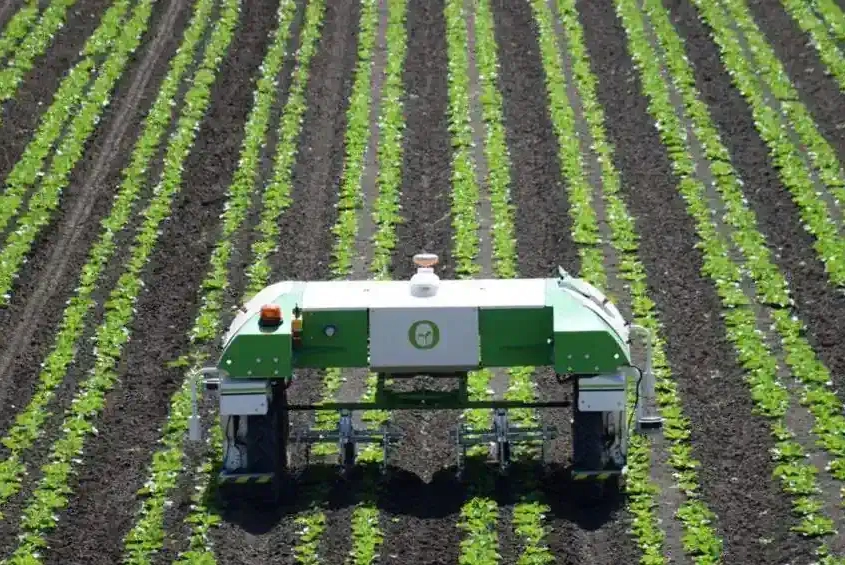
Fertilizer robots play a crucial role in modern agriculture by optimizing the fertilization process in row crops. Conventional fertilization methods often result in soil degradation and erosion due to the lack of consideration for specific plant needs. To address this challenge, precision agriculture applications utilize advanced technologies such as optical sensors and laser sensors. Multispectral cameras, for instance, analyze plant growth through NDVI indices, providing valuable insights for precise fertilization decisions. Laser sensors reconstruct vegetative environments, enabling analysis using clustering techniques and point cloud processing.
The Sureveg project exemplifies the application of cutting-edge technologies in robotic fertilization processes for row crop production. By incorporating sensors, robotic systems, and control boards, this project aims to optimize selective fertilization through the extraction of crop characteristics and relevant decision-making information. Tests conducted on cabbage and red cabbage rows have demonstrated the effectiveness of these sensors, both individually and in combination, in enhancing the fertilization of vegetables.
Fertilizer robots are part of the broader concept of smart agriculture, which encompasses various technologies and innovations revolutionizing farming practices. These technologies aim to increase efficiency, reduce labor requirements, and improve operational costs in the agricultural industry. Farm automation technologies, including fertilizer robots, have shown significant benefits such as cost savings per acre in vineyards. The adoption of these technologies is driven by factors such as rising fertilizer prices, concerns over inflation, increased labor wages, and stricter regulations on fertilizers and pesticides.
Nanotechnologies also hold promise in agriculture, including the reduction of water usage in farming. These technologies leverage the unique properties of nanoparticles to enhance fertilizer efficiency and reduce environmental impact. Cynthia Goh, a Professor of Chemistry at the University of Toronto, highlights the potential of nanotechnologies in agriculture.
In summary, fertilizer robots are integral to modern agriculture, optimizing the fertilization process in row crops and improving crop yield while reducing environmental impact. These robots, along with other smart agriculture technologies, aim to revolutionize farming practices by increasing efficiency, reducing labor requirements, and improving overall sustainability in the industry.
3.4 Agricultural Product Grading Robot
Agricultural product grading robots offer immense potential for revolutionizing the agricultural industry. These robots integrate advanced technologies to automate the sorting and grading processes, ensuring consistent quality and efficiency. The introduction of these robots addresses the challenges posed by the complex and variable nature of agricultural products. Genetic and environmental factors contribute to the high variability observed in agricultural products, necessitating precise and adaptable grading systems. By employing image processing and perception technologies, agricultural product grading robots can accurately analyze the characteristics and quality of produce. This automation enhances productivity, reduces labor requirements, and ensures consistent product quality.
Precision agriculture, which relies on the integration of robotics and advanced sensing technologies, has paved the way for the development and adoption of agricultural product grading robots. These robots play a vital role in the real-time interpretation of the agricultural environment, enabling efficient and accurate sorting and grading of products. By harnessing image processing techniques, these robots can analyze the visual characteristics of products, ensuring precise grading and sorting. The utilization of robotics in the agricultural sector has witnessed significant advancements over time, and agricultural product grading robots are at the forefront of this technological progress.
In summary, agricultural product grading robots offer a promising solution for enhancing the sorting and grading processes in the agricultural industry. These robots leverage advanced technologies, such as image processing and perception systems, to automate the analysis of product characteristics and ensure consistent quality. By integrating robotics and sensing technologies, agricultural product grading robots contribute to increased productivity, reduced labor requirements, and improved overall efficiency in the agricultural sector.
3.5 Weeding Robot
Weeding robots are a promising technology in modern agriculture, offering significant advantages in labor savings and reduced pesticide usage. Traditional weeding methods are labor-intensive and environmentally harmful, making the development of efficient and sustainable weed control solutions crucial. The integration of machine vision technologies in agricultural robots enables automated weeding robots that enhance efficiency, optimize resource utilization, and improve agricultural productivity. By leveraging computer vision, machine learning, and deep learning, weeding robots can accurately detect and remove weeds while preserving crops. These robots utilize perception, decision-making, and control technologies to navigate fields autonomously, providing effective weed management and reducing environmental pollution caused by herbicides.
Leading agricultural technology companies have made significant strides in developing weeding robots that offer innovative solutions. For instance, CarbonRobotics has introduced an autonomous robot capable of distinguishing weeds from crops using laser technology. This robot employs artificial intelligence, high-resolution cameras, and powerful GPUs for image recognition, enabling precise weed elimination while preserving nearby crops. It operates with GPS and LIDAR systems, ensuring accurate navigation and obstacle avoidance. Similarly, Naïo Technologies has developed multiple weeding robots, such as Oz, Ted, and Dino, each designed for specific agricultural applications, employing camera vision, sensors, and precise tool positioning.
Weeding robots present a significant opportunity for farmers to alleviate physical strain and protect crops efficiently. These robotic solutions offer a sustainable alternative to labor-intensive weeding practices, reducing reliance on agrochemicals and promoting environmental preservation. By harnessing advanced technologies and automation, weeding robots enhance agricultural practices, streamline operations, and contribute to the overall sustainability of the farming industry.
3.6 Seedling Robot
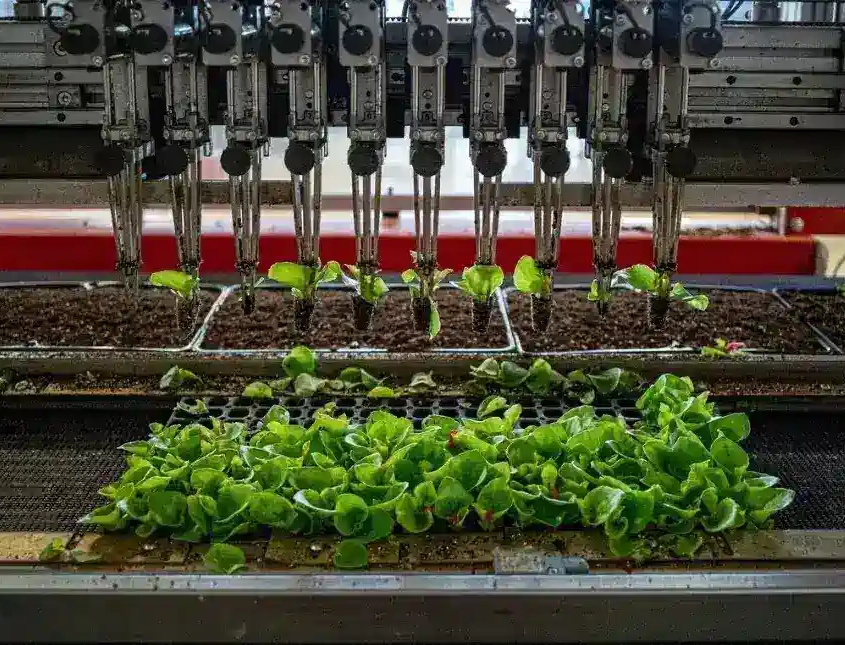
Agricultural robots are revolutionizing farming practices worldwide, including crop seeding. These robots offer a range of benefits, such as increased efficiency, reduced labor costs, and improved crop yields. The development of low-cost agricultural robots specifically designed for crop seeding has shown promising results. These robots utilize a mobile base and a seeding mechanism to sow seedlings into the ground continuously. In tests, the robot achieved a sowing rate of 138 seedlings in 5 minutes with 92% accuracy, outperforming human workers. The implementation of such robots in agriculture can significantly reduce labor costs and improve operational efficiency. By leveraging automation and eliminating the need for human intervention, crop production yields can be increased, and the industry can address labor shortages.
The global market for agricultural robots, including seeding robots, is projected to reach USD 74.5 billion by 2024, indicating the increasing adoption and potential of these technologies. The integration of Artificial Intelligence (AI) in precision agriculture has enabled farmers to optimize inputs like fertilizer, pesticides, herbicides, and water, leading to increased yields. Additionally, aerial imaging drones equipped with sensors like RGB cameras provide valuable insights into crop health and soil conditions, empowering data-driven decision-making in agriculture. The use of various types of drones, including fixed-wing, rotary-wing, and hybrid drones, offers flexibility in agricultural applications.
The development of smart agriculture robots, including those for crop seeding, addresses the challenges faced by farmers in terms of labor scarcity and changing environmental conditions. By employing sensors and automation, these robots save time, enhance energy efficiency, and optimize crop productivity. The utilization of advanced technologies, such as Arduino boards and wireless communication, allows precise control and monitoring of the robotic vehicles. The development of such innovative robotic systems contributes to the advancement of agricultural robotics and opens up possibilities for broader applications in the industry.
The progress in agricultural robotics, including crop seeding robots, is driven by the need for increased efficiency, reduced labor costs, and optimized crop yields. These robots leverage computational algorithms, environmental perception, and precision technologies to enhance production processes. Precision agriculture, enabled by small smart devices like sensors, drones, and trackers, allows for optimized detection, spraying, weeding, and harvesting of crops. The advancements in agricultural robotics, including crop seeding robots, contribute to the commercialization and ongoing development of these technologies in the agricultural sector.
3.7 Farming Robot
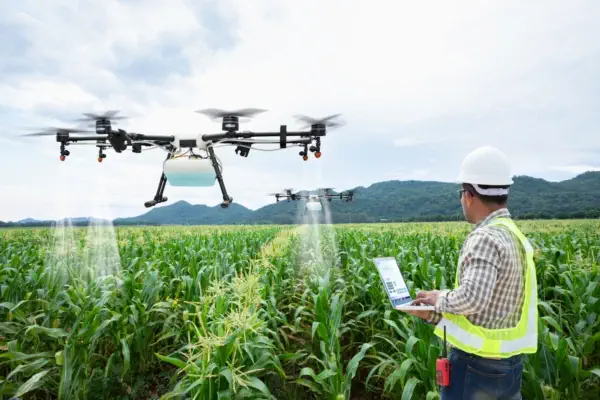
he adoption of farming robots in agriculture brings about significant transformations compared to traditional working methods. These robots offer several advantages and challenges that impact various dimensions of farm operations. The integration of perception, decision-making, control, and execution techniques has led to notable improvements, but limited integration with artificial intelligence remains a restriction for widespread use. However, farming robots are emerging as crucial contributors to digital agriculture, offering benefits such as flexibility, precision, increased productivity, and continuous operation without breaks . These robots can perform tasks like planting, irrigation, fertilization, monitoring, and harvesting, reducing the need for human labor. They operate at higher speeds, with fewer errors, and navigate obstacles effectively, leading to improved product quality and lower production costs.
The introduction of farming robots in agriculture also brings about transformations in farm structure, work organization, the meaning of work, and technical-economic performance. While the impact on work is complex, studies indicate that farm size is not necessarily correlated with robotization. Skill and wage segmentation may occur in the labor market, and work reorganization involves a decrease in physical workload but an increase in mental workload for monitoring alarms. Changes in the animal-human relationship can also lead to new farmer and worker identities. However, it’s important to note that the adoption of automated milking systems did not support a reduction in working time.
Smart farming and digital agriculture, enabled by agricultural robots, address challenges such as labor shortages, declining agricultural populations, and cultivation uncertainty due to climate change. These robots, including aerial and ground robots, facilitate data collection and crop management through remote sensing. They are increasingly utilized for tasks such as monitoring, spraying, and harvesting, reducing labor shortages and long-term costs. However, agricultural environments pose challenges due to crop diversity and varying robot platforms. Despite challenges such as high initial costs, maintenance requirements, and potential job displacement, robotics in agriculture offer effective solutions for improving productivity and transforming the industry.
The advancements in agricultural robotics have resulted in the emergence of various types of farming robots capable of performing tasks like picking apples, harvesting lettuce, gathering strawberries, and removing weeds. These robots are driven by the need to address labor shortages and meet the growing global population’s demands for food. While automation seems suitable for crop harvesting, the delicate nature of fruits and vegetables presents challenges for precise robot operations. Nonetheless, advancements made by agtech companies and academic institutions have shown promise in developing robots capable of picking ripe fruit and handling lettuce harvesting. These innovations have the potential to transform the industry and contribute to meeting critical agricultural needs.
4. Lithium Batteries for agricultural robots
Lithium-ion batteries play a crucial role in powering agricultural robots, offering numerous advantages over other battery technologies. These batteries provide high energy density, reliability, and faster charging capabilities, making them ideal for the demanding requirements of agricultural applications. Manly Battery offers specialized lithium-ion battery solutions tailored for small and medium-sized agricultural robots, including driverless transport vehicles and forklifts. These modular and expandable batteries, such as the “Easy Block” and “Easy Blade,” come in various versions with different power outputs, voltages, and energy capacities. For example, the “Easy Block” pack offers voltages ranging from 12.8 to 38.4 volts, while the “Easy Blade” pack provides voltage options between 24 and 48 volts.
Lithium-ion batteries have proven to be reliable and eco-friendly solutions for the energy requirements of agricultural robots. They offer longer lifespans, higher energy densities, and improved power and load capacities compared to lead-acid batteries, all in a smaller form factor. With their advanced technology, lithium-ion batteries contribute to operational efficiency in agricultural applications by reducing head length in truck and pallet loading, enabling narrower aisles, and maximizing storage space. Manly Battery, as a sustainable partner in the agricultural robotics sector, provides both standard and customizable lithium-ion battery options to meet the diverse needs of users and support the industry’s growth.
In the agricultural robotics market, battery power is crucial, considering factors such as accessibility, reliability, longevity, convenience, and cost. While lead-acid batteries were commonly used in the past, many designers are transitioning to lithium-iron phosphate (LFP), lithium nickel cobalt aluminum (NCA), or lithium nickel manganese cobalt (NMC) technologies for improved energy density and cycle life. Manly Battery’s experience in battery technology, such as the transition from lead-acid to NMC technology, demonstrates the significant benefits and market acceptance of lithium-ion batteries in terms of higher energy density, efficiency enhancements, and extended warranties. The use of cylindrical 18650 or 21700 cells allows for greater granularity in the design of the battery system.
Lithium-ion batteries also find extensive use in the automated guided vehicles and autonomous mobile robots (AGV/AMR) market, providing advantages such as longer run times, lighter loads, and faster, more efficient charging compared to lead-acid batteries. These batteries prove to be the optimal choice for mobile robots in various industries, including agriculture, as they offer superior performance, increased productivity, and enhanced workplace safety. While the exact voltages of lithium-ion batteries for agricultural robots may vary depending on specific applications and configurations, they typically range from 12.8 to 48 volts .
In summary, lithium-ion batteries provide the necessary power, reliability, and energy density required for agricultural robots. With their advanced technology and customizable options, these batteries contribute to the sustainable and efficient operation of autonomous mobile robots in agriculture.
5. Conclusion
The functions of agricultural robots are very complete and can replace part of human labor. Robots can do some things that humans cannot do, and their work efficiency is very high. They can engage in heavy manual labor, monotonous and repetitive tasks, such as spraying pesticides, harvesting and sorting crops, etc., which can liberate a lot of human resources. Robots are replacing or have replaced the heavy manual labor of humans, and can work continuously without interruption, which greatly improves labor productivity and is an indispensable and important link in the intelligentization of agriculture.
Glide on Water with Amazing Jet Surfboard
Table of Contents
- Glide on Water with Amazing Jet Surfboard
- History Of Electric Jet Surfboard
- Types of Electric Jet Surfboard
- Where and How To Ride Your Electric Jet Surfboard
- Riding Styles for Electric Jet Surfboards: Sporty or Relaxed?
- Choosing Your Electric Jet Surfboard: Handle or No Handle?
- Staying Safe on Your Electric Jet Surfboard
- The Thrill of Electric Jet Surfboard: Power and Speed
- Power Up Your Surf with LiFePO4 Lithium Batteries
- Cost of Electric Jet Surfboard
1. Electric Jet Surfboards: A New Wave of Fun
Electric jet surfboard bring a fresh way to enjoy the ocean and its waves. Here’s all you need to know about these cool motorized boards. Surfers have always loved riding waves on different types of surfboards. No matter the wave’s size or the water’s conditions, there’s a surfboard for everything.
2. What is an Electric Surfboard?
An electric surfboard is a special kind of board. It uses lithium-ion batteries to power up. This lets riders move fast on any water, like the ocean, rivers, or lakes. It has an electric jet system that you control with a remote. This means you don’t need waves to go fast.
3. More than Just Surfing
Electric surfboards aren’t trying to take over regular surfboards. Instead, they want to interest people who like boats and fast water sports. These battery-powered boards have a sleek design. They can start moving really quickly thanks to the smart technology inside.
History Of Electric Jet Surfboard
1. Journey of the Electric Jet Surfboard: From Early Ideas to Today’s Fun
The journey of electric surfboards started in 1935 in Australia with the creation of the first model known as “Surf Scooter.” This board was made to help lifeguards save people at Bondi Beach in Sydney. However, they stopped working on it after a few tries, and the idea went to sleep for 25 years. Then, in 1960, an American named Hobart “Hobie” Alter made a new type of surfboard with a motor. Fast forward to the early 2000s, and people tried to sell a surfboard that moved with the help of a jet. It took some time, but these boards have now become a popular choice for fun on the water.
2. Electric Surfboards Today
Today’s electric surfboards are easy to use and lots of fun. They are made for everyone. You don’t need to be a pro surfer to enjoy them. These boards are stable and help you move easily, almost like riding a jet ski. You can use them in all kinds of water, from big ocean waves to calm lakes. Plus, no matter how much you weigh, these boards can quickly get you moving over the water.
Types of Electric Jet Surfboard
In the water sports scene, you’ll mainly find two kinds of jet boards: the electric surfboards and the electric hydrofoils. Each has its unique way of making time in the water exciting!
1. Electric Surfboards
Electric surfboards are similar to the bigger surfboards you might see, often between 7 to 9 feet long. They are designed to let you smoothly glide over the sea, rivers, lakes, and more. You can enjoy a leisurely ride or catch the waves while standing upright. Typically, these boards are made from materials like carbon fiber and aluminum, making them light and strong. Some are rigid, while others can be inflated.
2. Electric Hydrofoils
Electric hydrofoil boards are all about speed and exhilaration. They have a special foiling structure that lifts you up, allowing you to make fast, snappy turns just inches above the water. This makes you feel as if you’re flying over the water! While they offer an incredible experience, they are best used away from crowded areas due to their speed and the skill needed to control them.
Where and How To Ride Your Electric Jet Surfboard
When you’re ready to ride your electric jet surfboard, it’s important to know where you can go and what rules you need to follow.
1. Electric Jet Surfboards on the Water
In places like Germany, jetboards are considered personal watercraft, similar to jetskis. This doesn’t matter much at sea, but if you’re on inland waters, there are specific rules. You need to ride on designated jet ski routes or in areas allowed for “Wanderfahrt,” which means you have to follow speed limits and can’t do wild turns.
2. Following the Rules for Safe and Fun Riding
Knowing and following these rules will keep you safe and ensure everyone can enjoy the water. It’s all about having fun without disturbing others or breaking any laws.
Riding Styles for Electric Jet Surfboards: Sporty or Relaxed?
When deciding how you want to ride your electric jet surfboard, consider whether you prefer a sporty or relaxed experience.
1. For the Sporty Riders
If you love making sharp turns and quick moves, go for a shorter jetboard equipped with foot straps. These boards might be a bit tougher to ride but allow for greater maneuverability. Although not necessarily faster due to their design dipping deeper in water, they’re great for those who want an active ride.
2. For the Relaxed Riders
Prefer a laid-back ride? Choose a larger board with more volume. Bigger boards are easier to handle and offer a more stable ride. You’ll find different sizes and volumes in a jetboard comparison table to help pick the best one for you.
Choosing Your Electric Jet Surfboard: Handle or No Handle?
When picking out an electric jet surfboard, you’ll notice some have handles while others don’t. Let’s look at what’s best for you.
1. The Deal with Handles on Surfboards
Some electric surfboards come with a leash that’s attached to the top of the board, complete with a handle you can hold onto. This leash might be removable on some boards, while other boards don’t have one at all.
2. Why Consider a Handle?
Handles are there for two main reasons. First, they make riding the board easier, especially for beginners. Second, they help you steer the board better. That’s why even some high-performance boards include handles. However, some people prefer riding without a handle because it feels more freeing.
Staying Safe on Your Electric Jet Surfboard
When you’re riding an electric jet surfboard, safety is super important. Here are some things to make sure your board has to keep you safe.
1. Always Use a Leash with a Safety Magnet
Your jetboard should have a leash with a safety magnet, also known as a kill switch. You wear this leash on your ankle or vest. It’s really important because it helps stop the board if you fall off. The kill switch makes sure the engine doesn’t start by accident and turns the motor off right away if you fall into the water, pulling the magnet out and stopping the motor.
2. Don’t Forget the Helmet and Vest
You should always wear a helmet and a vest, no matter what. They protect your head and body if you fall or hit something.
The Thrill of Electric Jet Surfboard: Power and Speed
Electric jet surfboards are all about speed and power, letting you zoom across the water like never before. Let’s dive into what makes these boards super fast and fun!
1. How Fast and Far Can You Go?
These surfboards are battery-powered and can move really fast! The top-notch ones have two jets and batteries that help you glide over water smoothly. They can go as fast as 40 miles per hour (65 kilometers per hour). You can enjoy the ride for about 45 minutes depending on how fast you go. Also, if something breaks, you can easily replace parts like batteries, handles, and fins.
2. Keep Going with Good Batteries
How long your ride lasts depends on the board, your weight, and the battery. Some boards need a recharge after 20 minutes of top-speed fun, while others keep going for up to six hours. Most of these boards let you change how much power you use, and you can swap out batteries to keep the fun going. Charging them up takes about 1 to 2 hours.
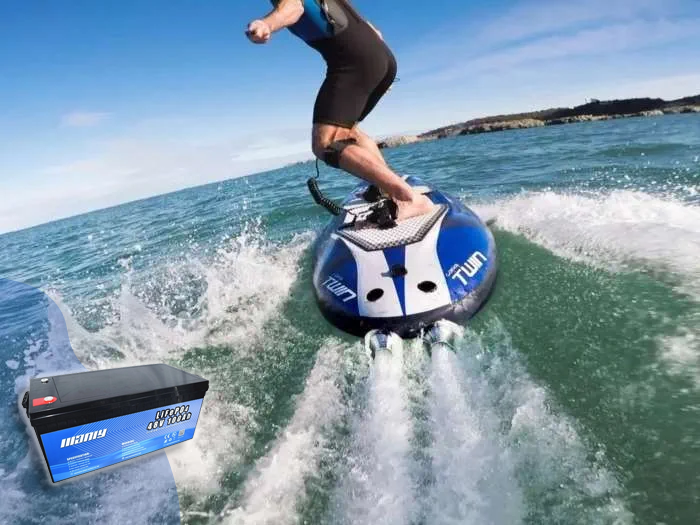
Power Up Your Surf with LiFePO4 Lithium Batteries
Electric jet surfboards are taking the water sports world by storm, offering an exhilarating experience unlike any other. At the heart of these cutting-edge surfboards lies the power source – LiFePO4 lithium batteries, a critical component for the modern rider seeking speed, stability, and longevity in their aquatic adventures.
LiFePO4, or Lithium Iron Phosphate batteries, are chosen for their exceptional balance of power and safety. These batteries are known for their long lifespan, providing riders with consistent performance over many charges. They’re also much safer, significantly reducing risks like overheating, which is crucial when you’re out on the water.
Durability is another hallmark of LiFePO4 batteries. They withstand a wide range of temperatures and conditions, making them perfect for the unpredictable nature of water sports. And with a higher energy efficiency rate compared to traditional batteries, riders enjoy longer sessions on the water with faster recharge times.
Selecting a dependable LiFePO4 lithium battery supplier is crucial. Consider MANLY Battery as a prime example. Their batteries come loaded with contemporary features like short circuit protection, overcharge safeguards, and IP68 waterproof rating. Moreover, they are robust, crafted to perform exceptionally in severe conditions, guaranteeing that your electric jet surfboard is prepared for action at any moment. Upgrade your business’s performance and reliability by choosing MANLY Battery for your LiFePO4 lithium battery needs – Shop now to empower your products with quality and innovation!
As you embrace the future of water sports with an electric jet surfboard, the LiFePO4 lithium battery stands as a testament to safety, efficiency, and unparalleled performance. Ride the waves longer, faster, and with peace of mind, knowing your surfboard is powered by the best in battery technology. For learn more about LiFePO4 lithium battery, please click below:
Cost of Electric Jet Surfboard
Electric jet surfboards are a super fun way to enjoy the water, but they can be pretty pricey. Let’s break down what they cost and why.
1. How Much Does Fun Cost?
A battery-powered surfboard will set you back quite a bit. Prices for the best jet-propelled boards range from about $5,000 to $10,000. What makes them so costly? Well, a lot of things like their design, how long the battery lasts, how powerful the motor is, and how fast it can go add up to the price.
2. What Makes Them Worth the Price?
The fancier boards have lots of cool features. You can swap out batteries for longer rides, control them with Bluetooth remotes, and enjoy the quiet motors. They’re built to glide smoothly over water and even have special designs to keep you stable and comfortable. Some even have GPS to help you track your ride and know when it’s time to head back.
3. Keeping Safe While Having Fun
Even though they are expensive, safety is super important. If you decide to give jet boarding a try, always wear a helmet. Hitting something or falling at high speeds is no joke!
Recently, Sungrow and Enlight Renewable Energy, a new energy giant, signed Israel’s largest energy storage project to provide a new generation of 430MWh 1500V liquid-cooled energy storage system, which will accelerate the transformation of the local energy structure and the pace of net zero carbon.
Under the global low-carbon transition trend, the Israeli government is facing tremendous pressure to reduce emissions, and plans to account for 26% of Israel’s energy structure in the next 10 years. Faced with the resulting difficulties in photovoltaic consumption and grid access, energy storage will become an important supporting technology.
Enlight is Israel’s largest new energy company and has always attached great importance to technological innovation, product performance and system safety. “The successful practice of Sungrow’s hundreds of megawatt-hour projects in North America and Europe is an important cornerstone of the cooperation between the two parties. After careful comparison and comprehensive inspection of many companies around the world, we finally locked Sungrow.” Mr. Gilad Yavetz, CEO of Enlight Commented.
Enlight and Sungrow are the first to build the largest local energy storage project of 430MWh. With a new generation of 1500V liquid-cooled energy storage system, Enlight leads the new direction of industry development, and plays an important role in demonstrating and promoting the large-scale application of “new energy + energy storage” in Israel.

